ISLANDS. Or: the post-colonial artist and the absent institution.
44th AICA Congress, Asunción, Paraguay, 18.10.11
Granted Independence from Britain in 1966, Barbados can be seen as the quintessential postcolonial island-nation. This is a place where art, to the political establishment, has been linked with cultural nationalism and, more recently, the hope of increased revenues.
Visual art, here, exists without permanent or transparent support systems: the Barbadian government has never erected a building dedicated to any art form, its cultural agencies are under-funded, no public art collection is on permanent display. Private galleries have been episodic and corporate support for the arts is virtually non-existent. The daily press is averse to printing serious art criticism – and artists can look in vain towards academia for critical support: in their effort to part with the cultural models and hierarchies of the west, the local intelligentsia has generally favored the popular expression. Art forms, which conversely (even by default) carry associations of cultural elitism, have been regarded as unsuitable vehicles for the cultural nationalism of a post-colonial nation. Save the momentous, but now dated publication ‘Art in Barbados’ from 1998, in addition to the broader international surveys of Caribbean art and the occasional catalogue-essay, Barbadian artists therefore operate in a critical as well as an institutional vacuum. Bluntly put: visual art has been the ‘unloved child’ in Caribbean cultural studies as well as Barbadian cultural policy.
In these circumstances, it is hardly surprising, that many Barbadian artists have surrendered their talents to the pursuit of the tourist-market, while others have left, hoping for better opportunities overseas. Yet, a number of serious artists remain. Three of these – Winston Kellman, Nick Whittle and Ras Ishi Butcher – have occasioned the following reflections:
Coming into maturity in the early decades after Independence, these artists were inspired by the region’s prominent intellectuals – Fanon, Cesaire, Walcott, Brathwaite – to invest themselves deeply in the idea of cultural autonomy. Yet, as the postcolonial state took shape, it gradually became clear, that contrary to the visions of these intellectuals, culture (except in Jamaica) was not going to play a major role in the building of small island-nations. The initial romance between artists and state began to cool off.
Meanwhile, when the international art-world momentarily set eyes on the Caribbean during the 1990s, it inspired the hope among some artists, that the external world had come to the rescue and that the nation would finally discover its hidden resource, through external intervention. Yet, when the dust had settled, nothing had changed, except that cultural policy-makers started to talk about grooming artists for the international market by forging links with Caribbean artists of the metropolitan diaspora.
I now wish to argue that this trajectory has changed the inscription of certain Barbadian oeuvres, and that these oeuvres now, in a sense, speak back to a deficient institution and an absent audience.
Winston Kellman is, at first sight, a conventional plein-air landscape-painter. He lives in a plantation-cottage, and the surrounding countryside is his only motif.
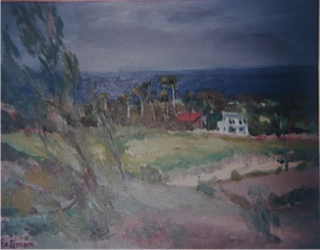 |
Winston Kellman: Warleigh Plantation, from the Sugar-cane series 1987, oil on canvas. |
Yet, his activity is more than nature-romanticism – it is a project deeply inscribed by the post-colonial experience. Kellman paints the Barbadian landscape like someone obsessed. For three decades, he has sketched and painted every angle, color, shade, texture and transformation of this landscape – an activity, which can best be described as ‘forensic’. It is, of course, the trauma embedded in the land he has sought to excavate; not only the brutality of the colonial era and the sugar-industry, but the impact of this legacy on the present: the region’s continuing social hierarchies, its paranoia and lack of cultural confidence. Kellman’s dogged repetition has been a quest for wholeness and closure, and his adaptation of the European landscape-tradition, the language of the historical oppressor, has metaphorically invoked a psychological stumbling-block: the inability, on the part of the artist as well as of his nation, to move on until an underlying trauma has been addressed.
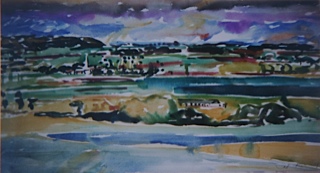 |
Winston Kellman: From the Sugar-cane series (1995), watercolor |
Since Kellman started his project, conditions for the visual arts have largely remained unchanged and he himself has never really been acknowledged as an artist of unquestionable significance. Remarkably, however, Kellman’s response to this has been a redoubling of effort – an acceleration of output, larger drawings, more of them. But the inflection of this activity has become one of personal as well as cultural resistance, and its primary significance is perhaps the protracted and demonstrative futility of its material accumulation.
IMAGES:
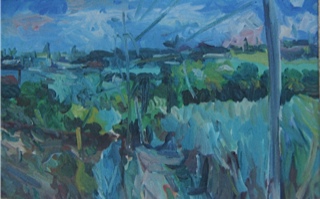 |
Winston Kellman: untitled landscape from the ‘Seasons-series’, 2001, oil on canvas |
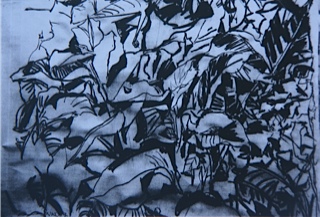 |
Winston Kellman: untitled drawing from the Mud and Flowers-series, 2007, charcoal |
Though Nick Whittle was born in Birmingham, his artistic career has unfolded in Barbados. Since his arrival in 1979, he has campaigned for the development of visual arts support systems. Yet, as an artist – and an immigrant, whose work has been both controversial and difficult for the average viewer to access – he has always found himself on the margins of what has been considered nationally representative. Naturally, the simultaneous experience of alienation and connection with his adopted nation has profoundly influenced Whittle’s oeuvre, as exemplified in “Full Fathoms Five”.
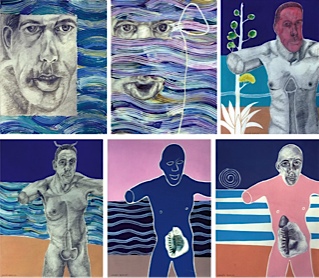 |
Nick Whittle: Full Fathoms Five (1996), mixed media |
We see here the hopeful artist arriving in the island with his arms raised in the expectation of embrace. Instead he finds himself amputated and ridiculed until his identity gradually becomes androgynous: both colonizer (male/white) and colonized (female/dark). Whittle’s work has thus, among other things, drawn attention to the ‘white predicament’ in the post-colonial era and to the ticklish question ‘to whom does the new nation belong?’ Most viewers, however, have not seen past the phallic shape, which has been Whittle’s symbol for the colonial project, and despite the incontrovertible pertinence of his subject-matter, his work has largely been met with embarrassed silence.
In an effort to subvert the power-dynamic between himself and an absent or reluctant audience, Whittle’s more recent work has taken the shape of transitory constructions, which are dismantled after their exhibition.
IMAGES:
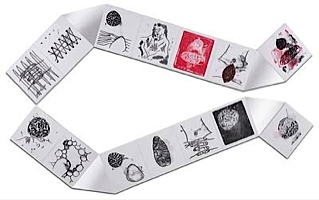 |
Nick Whittle: Big Fish (2009), mixed media |
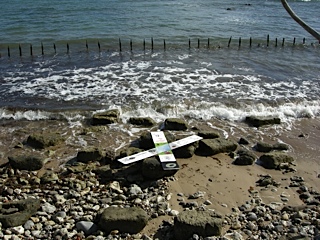 |
Nick Whittle: X (2009), photography and mixed media |
These constructions are characterized by biographical content and symbolic form, alluding to the fate of the visual arts and the artist. Some constructions are never exhibited at all, but photographed in various locations and then dismantled: before anyone can fail to notice the work, it is now the artist himself, who denies the work an afterlife, now offering only a reduced and indirect version of the original.
IMAGE:
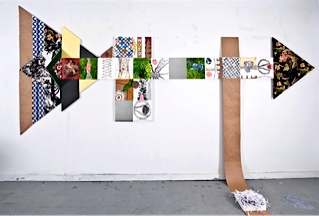 |
Nick Whittle: Open-Ended (2010), mixed media |
Unlike the former two, Ras Ishi Butcher has arguably been as successful as it is possible for a Barbadian artist to be. Butcher’s oeuvre has revolved around the diasporic experience, expressed through a characteristic ‘primitivist’ style, as for example in the diptych ‘400 Years’, where the continents of the world are pulled together by the plantation-overseer’s whip.
IMAGE:
 |
Ras Ishi Butcher: 400 Years World Order (diptych, LEFT PANEL), 1994, oil on canvas |
Along with fellow artist and Rastafarian Ras Akyem Ramsay, Butcher introduced the idea of art as social critique to Barbados and, for many years, the two were more or less permanently embroiled in controversy. However, as the Rastafarian movement has lost its revolutionary aura, Butcher (and Ramsay) has become a nostalgic emblem of pan-African grassroots activism, frequently representing Barbados in Caribbean survey-exhibitions and publications. It is compelling, however, that this celebrated artist, more loudly than anyone has objected to the lack of recognition and support for visual art in Barbados and that Butchers focus now has shifted entirely from the fate of the African diaspora to the fate of the artist.
This became clear, when Butcher, in 2009, unveiled the largest coherent body of work ever produced by a Barbadian artist (while its scale may fail to impress by international standards, it must be appreciated, that this work is produced in a small domestic space).
IMAGE:
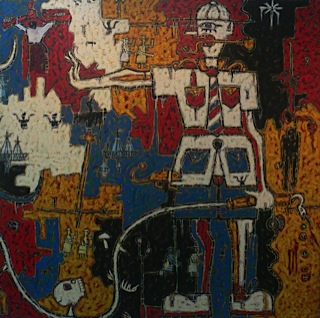 |
Ras Ishi Butcher: 400 Years New World Order (diptych, RIGHT PANEL), 1994, oil on canvas |
This body of work is made up of several series of paintings, consisting of many panels, each carrying innumerable little images, signs, pictograms and objects and everything adhering to complex, alternating symmetries. The physical effort, on the part of the artist, of reconciling detail and whole in these works cannot be overstated: it is a tour-de-force of orchestration, and it presents itself to the spectator as a kind of architecture, demanding the s/he too continually repositions herself to appreciate its totality. It was therefore a savage irony, that no exhibition-space in Barbados could hold all of these works together, and that the two largest pieces had to be installed at a separate venue: the statement was literally denied institutional completion.
IMAGES:
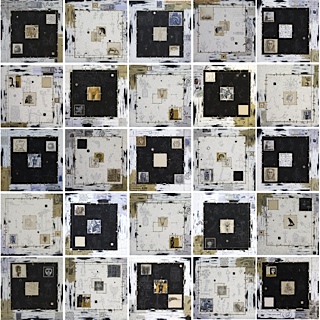 |
Ras Ishi Butcher: Battlefield (2006-08), mixed media (polyptych) |
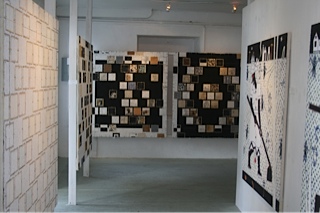 |
Ras Ishi Butcher’s work installed at the Old Pharmacy Gallery, Speightstown, 2010 |
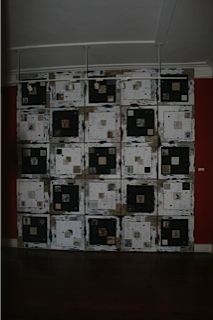 |
Ras Ishi Butcher’s ‘Battlefield’ installed at Lancaster House, Barbados, 2010 |
While this body of work is riddled with both secret and overt meaning, two things are clear: the second most important message was about the fate of the visual arts in Barbados, as a close scrutiny of the largest piece ‘Battlefield’ would reveal. But the most important message was scale itself. More than the artist wanted the viewer to think about his work, he wanted him to feel its overwhelming physical presence.
What I have suggested, is that these artists, who initially set out to resist the cultural dominance of the West and to develop aesthetic strategies suitable for the Caribbean, have turned to acts of individual defiance. But what does it mean, that these acts of defiance draw attention to the most unique feature of the visual arts – its very materiality?
At one level, Kellmans compelling accumulation, Whittle’s conditional presence and Butcher’s exponential enlargement remonstrate against the absence of mechanisms, which would offer critique, context and validation, mechanisms, which would redeem the latent monumentality of these statements, if also make them redundant. But perhaps more importantly, these measures deploy the one aspect of artistic practice, which is not constructed through critical discourse. As a last resort, these artists return to the primacy of ‘materia’ – to that which, at the best of times, confronts the critic with his limitations.
Moreover, the dynamic outlined here is, needless to say, exceedingly subtle and entrenched in local conditions. So what are the prospects, I wonder, of the depth or significance of such gestures ever registering as such anywhere else? When Barbadian policy-makers seek to usher Barbadian art into the international arena, I believe it compounds the challenges for an art, which orients itself – but never has been redeemed – nationally; for an art, which has attained more autonomy than it ever bartered for; and indeed for artists who, in the process, have become islands themselves.
(This paper is an abbreviated version of a long essay titled ‘Subtle Monuments’).
© Therese Hadchity
Todos los derechos resevados AICA Paraguay © - Contacto


